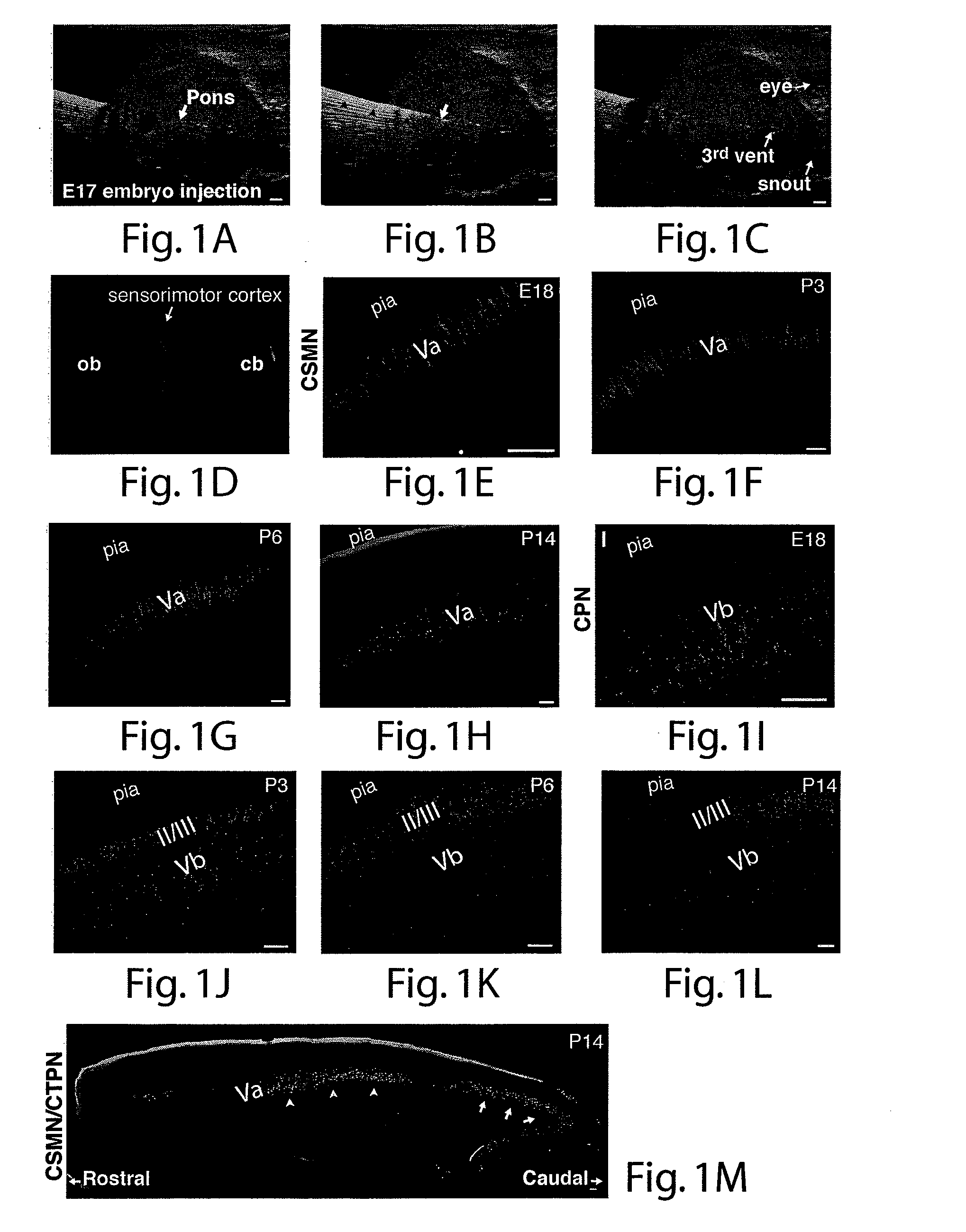Methods and compositions relating to neuronal cell and tissue differentiation
a neuronal cell and tissue differentiation technology, applied in drug compositions, instruments, library screening, etc., can solve the problems of complex molecular characterization of single neuronal populations, and achieve the effect of supporting growth and/or survival
- Summary
- Abstract
- Description
- Claims
- Application Information
AI Technical Summary
Benefits of technology
Problems solved by technology
Method used
Image
Examples
example 1
Neuronal Subtype-Specific Genes that Control Corticospinal Motor Neuron Development In Vivo
Experimental Procedures
Neuronal Subtype Labeling.
[0181]All neuronal subtypes were purified from C57BL / 6 mice (Charles River Laboratories, MA). The day of vaginal plug was designated E0. CSMN were retrogradely labeled with green fluorescent microspheres (Lumafluor Corp., FL) injected into the pons-midbrain junction (E18), the pons (P3), or the cervical spinal cord at the C2-3 or C5 level for P6 and P14, respectively. For embryonic injections, E17 pregnant mice were deeply anesthetized with Avertin and each embryo was injected through the uterine wall into the pons, using a VisualSonics Vevo 660 ultrasound-guided microinjection system (VisualSonics; Toronto, Canada) to precisely control the position of the injection site (FIG. 1A-C). Two injections per embryo were performed, with a total of 60-80 nl of green fluorescent micro spheres per injection site. The pregnant dam was deeply anesthetized o...
example 2
Fez Specifies Fate of CSMN
[0248]Towards the goal of identifying genes involved in specifying individual subtypes of projection neurons, we identified genes specific to corticospinal motor neurons (CSMN), clinically relevant cortical output neurons, which degenerate in amyotrophic lateral sclerosis (ALS), and whose injury contributes to the loss of motor function following spinal cord injury. As shown above in Example 1, we found genes specific to CSMN, as well as genes more broadly expressed in the highly related population of subcerebral projection neurons of layer V.
[0249]From this previous study, we sought to identify transcription factors that might be involved in the earliest events of CSMN fate specification. One molecule, Fez (Forebrain Expressed Zinc finger-Like; also called ZFP312), is a particularly promising candidate for several reasons. The pattern of Fez expression is consistent with a role in fate specification of subcerebral projection neurons. As shown above in Exam...
example 3
Ctip2 Involved in Development of Medium Spiny Projection Neurons of the Striatum
[0254]The medium spiny projection neurons of the striatum are one of the critical populations of neurons that degenerate in Huntington's disease. The identification of critical genes governing the differentiation, maturation and survival of medium spiny neurons is critical for developing new therapies 1) to prevent the degeneration of medium spiny neurons in Huntington's disease, 2) to recruit precursors and direct their differentiation into medium spiny neurons, and 3) to direct stem or progenitor cells in vitro to differentiation into medium spiny neurons for transplantation.
[0255]We observed that CTIP2 is expressed at extremely high levels in the striatum and areas of striatal neurogenesis throughout development. By analysis of multiple cell type specific markers using immunocytochemical methods, we found that within the striatum, CTIP2 is expressed specifically in medium spiny neurons. Because CTIP2 ...
PUM
| Property | Measurement | Unit |
|---|---|---|
| temperature | aaaaa | aaaaa |
| temperature | aaaaa | aaaaa |
| cellular heterogeneity | aaaaa | aaaaa |
Abstract
Description
Claims
Application Information
 Login to View More
Login to View More - R&D
- Intellectual Property
- Life Sciences
- Materials
- Tech Scout
- Unparalleled Data Quality
- Higher Quality Content
- 60% Fewer Hallucinations
Browse by: Latest US Patents, China's latest patents, Technical Efficacy Thesaurus, Application Domain, Technology Topic, Popular Technical Reports.
© 2025 PatSnap. All rights reserved.Legal|Privacy policy|Modern Slavery Act Transparency Statement|Sitemap|About US| Contact US: help@patsnap.com



